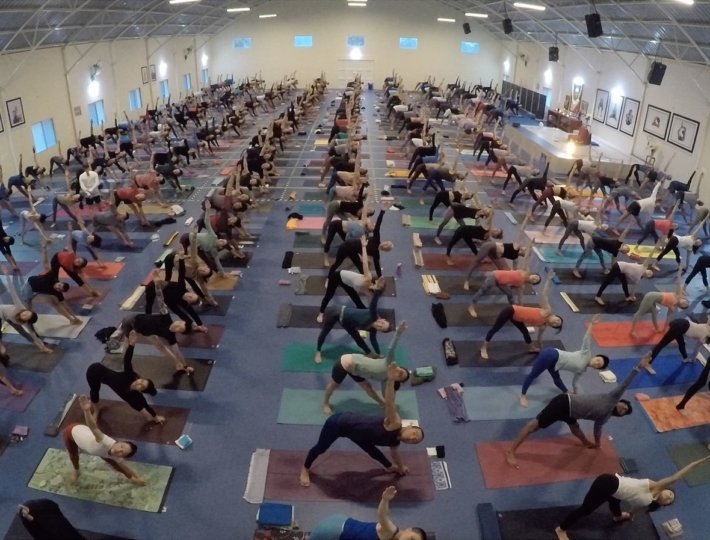The Skillmill has the makings of a familiar fitness device, but don’t call it a treadmill. The new apparatus, which made its U.S. debut this spring, features a similar platform and belt designed for indoor running, but the likenesses stop there.
The device’s concave platform curves upward on the ends like a smile, and when you step on the molded slats you quickly discover this machine is missing a motor. To move the conveyor belt-like surface, you need to harness your own energy, similar to a bike, rather than rely on a wall outlet to power the equipment.
As you pick up the pace, you’ll find it impossible to heel-strike, which is a controversial running-style. Though a study published in Gait and Posture reports that this is how most people instinctively run, many experts believe that the sheer force of striking the ground with your heel can create a jarring effect to the skeletal system, and may ultimately lead to injury. The Skillmill’s unique curvature supports a more widely encouraged form of running—short, quick strides where the forefoot hits the ground first to cushion the impact.
With a better stride and no set pace, I was able to easily surpass my usually max speed of a 6.2 minute-mile, and hit a 7.2 minute-mile (well outside of my comfort zone) without the intention to go that fast. Amazingly, my body could handle the stress just fine. It was my cardiovascular system that gave out first, forcing me to slow down to gasp for air within 30 seconds of reaching my top velocity. Going for a long run on the Skillmill would be incredibly hard, and apparently unnecessary. Machines, like this one, were made for high-intensity interval training, not for building endurance.
“Because it’s non-motorized, the Skillmill is completely controlled and propelled by the force of the user. This was designed to push the exerciser’s body to the limit,” says Michael Zieminski, a home-wellness manager and master trainer at TechnoGym, the leading global supplier of products and services in the fitness industry, which brought the Skillmill to market. Since the machine can’t hold a manually selected pace, like on a treadmill, there’s no cruise-control option. Instead, your body will go as fast as humanly possible simply because it can. Science says that’s a good thing.
According to a new study published in PLOS One in April, short bursts of arduous efforts—even as little as 60 seconds—may be just as effective at improving health and fitness as 45 minutes of moderate exercise. Canadian scientists split 25 out-of-shape men into three groups: 1) endurance exercisers trained for 45 minutes on a stationary bike, 2) high-intensity interval training (HIIT) exercisers did 20 seconds all-out on a bike and 2 minutes easy for a total of 10 minutes, and 3) non-exercisers changed nothing in their routine. After three weekly sessions for 12 weeks, they discovered the endurance group, who rode for 27 hours total, and the HIIT group, who trained for 6 hours total (with only 36 minutes of strenuous exercise) saw identical fitness and health gains despite the discrepancy in volume and time commitment.
What makes short, all-out training so effective? It doesn’t hold you back. “We’re all victims of our own minds sometimes. The treadmill limits your potential,” says CrossFit coach Kenny Santucci, director and creator of Body by Solace in Manhattan, who is considering a Skillmill for his fitness facility. “You might say, ‘I can’t go to 12 because that’s too high so I’ll stay at an 8- or 9-minute-mile pace.’ With the Skillmill, your potential is limitless. If I shorten your time and ask you to sprint, you’d be surprised. You’re only limited by what you think you can do.”
The machine’s potential (and your own) doesn’t end there. Two standout features add an extra layer of training: the sled push and magnetic lever. A U-shaped handlebar attachment at the front of the Skillmill invites you to grip the top ends for a straight-arm sled push or rest of your forearms below for a lower push. Using the built-in, magnetic lever on the righthand side you can add resistance, from 0 to 10, much like upping the incline would on a treadmill. At levels eight to 10, sled pushes will fire up various muscle groups as you walk forward, sideways, and/or backwards.
“The Skillmill could replace half the equipment I’d have to buy,” Santucci says, noting that a traditional sled push requires up to a 50-yard stretch of space, which is tight in New York City. On the Skillmill users could do high-resistance pushes that target hip range of motion, the posterior chain and upper body strength, all while basically staying in place.
Related: The Cardio Workout You’re Not Doing But Should Be
“As soon as you add resistance, it’s going to affect the posterior chain, in particular the glutes and the hamstrings, therefore, increasing your metabolic rate, or calorie burn, as you propel yourself forward,” Zieminski explains. For sprints, it’s best to set it at zero. For power-walks, anywhere between one to three is ideal. For power development, especially in a high and low sled push positions, you’ll want that lever closer to 10 for short bursts (about 10 seconds) of hard-as-hell work. If you come across a Skillmill in your local fitness facility—Equinox and Life Time Fitness will soon have them available—or can afford the hefty price tag (the Skillmill Go starts at $6,890) to add one to your home gym, here’s a fast workout to get you started.
Warm-up: 3-minute power walk at resistance level 2, 30 seconds of skipping on level 1, and 30 seconds of lateral shuffles on each side at level 3 to 5.
All-out sprint: 100 meters (or .06 miles) resistance free sprints. Recover for one minute, then repeat for a total of 5 sets.
High sled pushes: Using the dual handlebar, with your hands high and arms straight, push with fast, high knees at a resistance level of 5 to 7 for 30 seconds. Walk to recover for 30 seconds, then repeat for a total of 5 sets.
Low sled pushes: Using the dual handlebar in the low position, give it your all at a resistance of 8 to 10 for just 10 seconds. Rest for one minute, then repeat for a total of 5 sets.
Power-walk: At a resistance of 2 to 3, power walk for 2 minutes.












Comments (0)